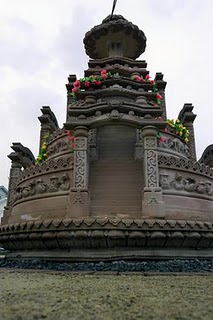As an Oshwal who grew up in East Africa, my identity is clear. I hail from a prosperous migrant community of high-achieving individuals. Traditionally, we are businessmen and traders, and congenital economists (remember the acronym for what a SHAH is? Sastu Hoi Apnu Hoi! That which is at the right price, will be ours!) Thinking of getting a good bargain for anything in life? You need to meet an Oshwal. Economy is in our blood!
No surprise then that a community which, at the turn of the nineteenth century, lived in clusters of mudshacks and communal courtyards, is now, in the twenty first century, a prosperous, wealthy and relatively stable community. Our homes are relatively palatial (to say the least!), our cars are grand, we have seamless access to world-class education, and it's not long before we'll be running global superpowers (cue. Sonal Shah's 2008 appointment to Barack Obama's transition team).
Amidst all this prosperity, however, I contend that the following have crept in to the Oshwal ethos: arrogance, a sense of superiority, and an almost apocalyptic erosion of fundamental values that originally drove our pioneers to get us to where we are today!
My problem is this: Oshwals are inherently meant to be Jains. The Jain Aum has been embodied as the logo of several of our educational and social institutions. You will find that our community centres are mostly annexed to a Jain temple or shrine. Jainism, a universal philosophy, emphasises non-violence (ahimsa), non-possessiveness (aparigraha), non-stealing (asteya), self-control (saiyyam, or what I like to refer to as brahmacharya), adherence to the Truth (satya) and pluralism (anekaantavaad). Now hopefully it becomes self-explanatory how "arrogance, a sense of superiority, and an almost apocalyptic erosion of fundamental values" are inconsistent with the very fundamentals of Jainism.
A replica of the Samovasaran - from where it is believed that Mahavir taught Jainism
So, as an Oshwal I am clear. I am successful, prosperous and proud of my social background. However, as an aspirant of Jain values, I am perplexed.
Allow me to explain...
When I grew up in Mombasa, Kenya (the birthplace of the Oshwal diaspora's present-day prosperity outside India), I was often exposed to a sense that Oshwals were the best at everything. We were the only community with so much unity; with a flourishing medical fund that provided medical insurance to those who needed it; with the best private schools in East Africa; and with an education fund from which we could take interest-free loans to finance our studies at some of the world's premier institutions. No other Gujarati community, at the time, had any such opportunities. On the social front, we had a plethora of youth leagues which ensured that our social calendars were always full with exciting community events (children's parties, competitions, sports days (the famous telegames!).
So when I first came to the UK, I had it engraved in my psyche that I was the best and I came from the best! I soon learnt the hard way and realised that I was not the "creme de la creme" that I once thought (with almost divine conviction!) I was.
This is precisely the problem. We think that our way is the best. So much so, that we've enveloped our religion into this psyche. I did not realise it at the time, but there was in Mombasa, during the time of my childhood and adolescence, a growing phenomenon of what I would now dare to call Jain extremism. Impressionable minds were being taught that Jainism is the only way, that going to the Hindu temples was taboo, that going to enjoy the Navratri festivities was contradictory to Jainism, and that a married Jain woman had to be sari-clad both inside and outside the home (other forms of very modest and decent dressing were just not acceptable - married Jain women had to adorn a sari and that is it - there was no qualification to that rule). Soon there were unspoken contests between teenagers - who could fast for the longest period at the next Paryushan?
The trouble is that some of this extemist ethos continues today. It might not continue to exist in Mombasa today (or it might - I don't know - if you live in Mombasa you can be the judge of that), but it certainly exists amongst certain families here in the UK, the USA and India.
So my question is this: how are any of these consistent with the Jain tenets? Mahavir Swami taught us that there are many approaches to the Truth, and that no one approach was exclusively the correct one - anekaantavaad (the multiplicity of viewpoints). This beautiful principle is a key, but often forgotten, tenet of Jainism as practised by the layman (the shraavak/shraavika). If we are to follow Jainism in its essence, then we need to cultivate a new ethos; an ethos that allows us to bask in our glory and prosperity, but at the same time ensures that we accept and make a reasonable attempt at understanding other people's ways of approaching the Truth, other people's customs, and, most importantly, the cultures of others.
 Paras Maalde
Paras Maalde
